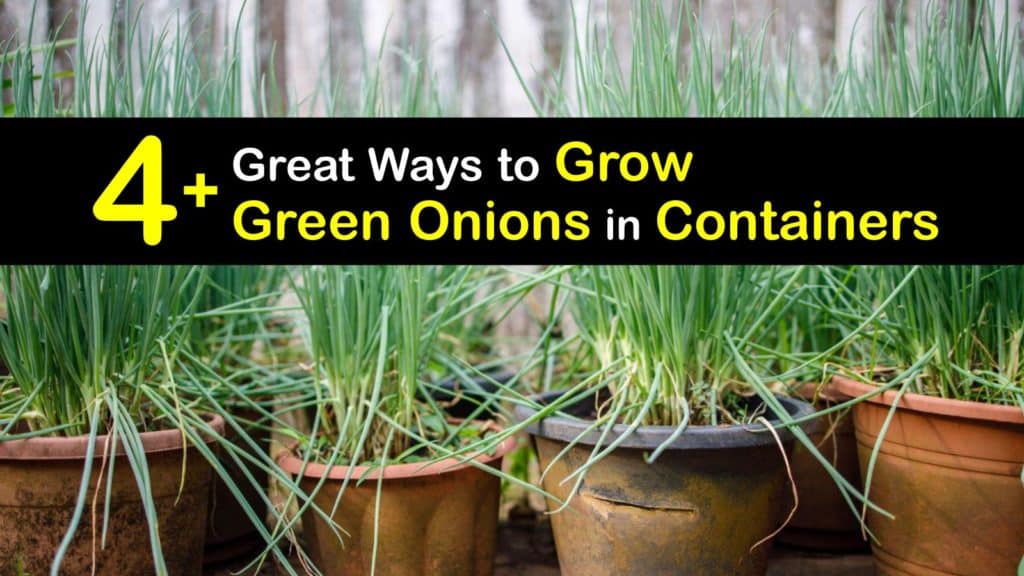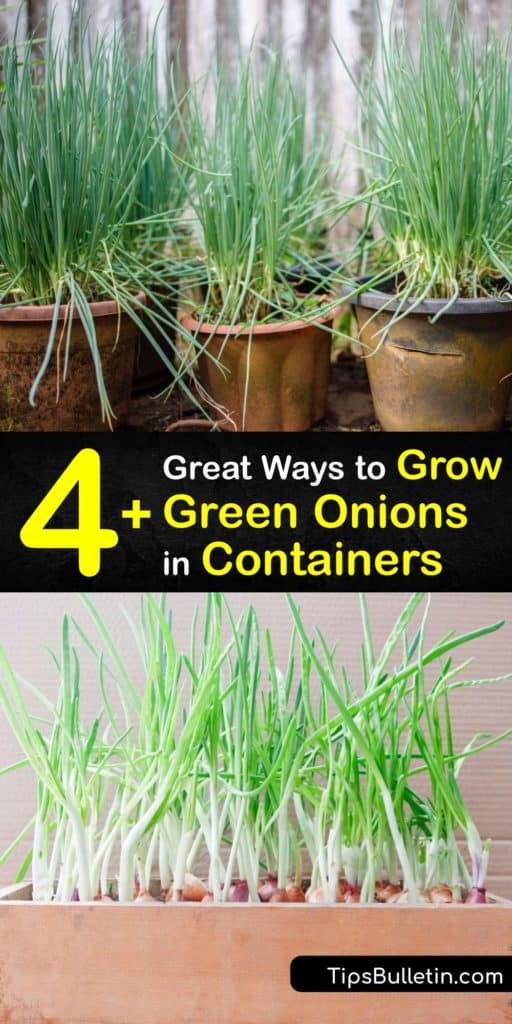Green onions are one of the simplest veggies to grow in containers. It’s even possible to keep them going year-round without much effort. In this article, you’ll learn everything you need to know about growing green onions in containers.
Green onions, or Allium fistulosum by their botanical name, are sometimes called bunching onions or spring onions. They’re in the same plant family as red, white, and yellow onions, scallions, shallots, leeks, chives, and garlic.
When it comes to planting green onions in containers, all that’s required is a sunny location, nutrient-rich potting soil, all-purpose plant fertilizer, and plenty of water. Make sure your pot has drain holes at the bottom to prevent problems with rot and fungal disease.

How to Grow Green Onions in Containers
Have you ever wondered how to plant green onions in a container? Does the difference between green onions and scallions matter when growing them in a pot? There are several approaches for how to grow green onions in containers, whether you grow green onions indoors or outside.
Choose between planting green onion seeds directly in your pot, transplanting onion sets purchased from your local garden center, or regrowing the ends of green onions from the grocery store.
It’s reasonably straightforward to overwinter your green onions indoors. They thrive at temperatures between 55-75℉, and require partial to full sun, meaning at least four or five hours of bright light each day.
What are scallions? Green onions are immature onions that get harvested before the onion bulbs have a chance to form. Some people enjoy the small bulbs’ flavor and allow them to mature longer before harvesting the entire plant.
Otherwise, snip the green tops once they reach your desired length, leaving the root intact when regrowing green onions for a continuous harvest.
Container planting to grow green onions from bulbs or seeds is the perfect solution if you have a small garden or if you don’t have a garden bed where you live. When you compare onions to shallots in the growing process, they are quite similar.

Thanks to their shallow root system, it’s possible to grow onions in small pots. Keep them on your porch or patio during the warmer months, then bring them in to live on a sunny windowsill for the winter. Growing scallions indoors is just as easy as having them outside.
To regrow green onions from the grocery store, whether spring onion vs green onion, cut the green stems where they begin to turn white at the base. When growing onions in pots, make a one-inch-deep hole in the soil and insert the end of the bulb.
Gently press the soil around the bulb with your fingers to secure it in place and thoroughly water it in. New leaves usually emerge in about four or five days. In general, expect to get three or four harvests of green shoots before planting new bulbs.
Spacing between green onion plants should be approximately two or three inches. If you’d prefer to let your green onions develop small bulbs, plant them a bit farther apart.
Best Type of Container for Growing Green Onions
Green onions are highly adaptable regarding their growing conditions. Since they have shallow roots, a six- to eight-inch-deep pot works well. How far apart to plant onion sets depends on the pot. Select a container wide enough to plant as many onion sets as you’d like to grow.
Any type of material is acceptable for your container as long as it has drain holes at the bottom. Or, try making a DIY green onion planter by repurposing a plastic tub from food packaging by cutting small drain holes along the bottom edges.
How to Grow Green Onions from Seed
While planting sprouted onions is easy, planting green onion seeds directly in the container in which you’ll be growing them is just as simple. There is no difference between green onions and chives when grown this way. Use your finger to create a slight depression about a quarter-inch deep in the soil where you want to plant each onion set.
Onion seeds are tiny, so it’s beneficial to use a straw or moistened fingertip to place them in the soil. Sow the seeds in the depressions you made and lightly cover them with soil.
Use a clean spray bottle to saturate the soil lightly without disturbing the seeds. Green onion seeds’ germination typically takes about four to ten days. Seeds germinate slower at colder temperatures, so keep them around 65-70℉.
Once they sprout, move your container to a sunny windowsill where the seedlings receive at least five or six hours of bright light each day.
After three or four weeks, fertilize them with all-purpose, organic liquid fertilizer. Under optimal conditions, when to pick scallions is between 40-50 days.
Best Soil and Fertilizer for Planting Green Onions in Containers
For best way to grow scallions and other onion types, use a potting soil mix that is well-draining and rich in organic matter. Try to find a blend with added perlite for drainage, coconut coir or peat moss for moisture retention, and compost for slow-release nutrients.
Or, try making a DIY potting mix using these simple ingredients.
Use a hand trowel to combine the ingredients in a large bucket with a lid. It’s best to use all of your homemade potting soil right away. Otherwise, store it sealed in a cool, dry place.
In addition to providing them with nutrient-rich soil, it’s also crucial to regularly fertilize your green onion plants. If you’re using liquid fertilizer, apply it every two to three weeks. For granular fertilizer, applications should be spaced five or six weeks apart.
Growing Green Onions in Containers Indoors
To enjoy an endless supply of green onions all year long, try growing them on a sunny, south-facing windowsill. If you don’t have a location in your home that gets full sun, don’t worry. Green onions will still grow in partial sun, albeit slower. This is also the best way to grow shallots.
When you plant onions indoors, the plants consume water at a slower rate than when grown outdoors. In addition, they use water at different speeds during various seasons throughout the year.
Avoid overwatering your green onions, as soggy soil poses a risk of fungal disease and insect infestations. It’s best to water your plants on an as-needed basis rather than sticking to a watering schedule.
To check whether your green onions need water, insert your fingertip into the soil up to your first knuckle. If your finger comes out mostly clean, it’s time to water. If soil sticks to it, wait another few days and reassess.
Common Pest and Disease Problems for Green Onions
Although green onions are incredibly easy to grow, they sometimes suffer from a handful of commonplace pest and disease issues.
Plants are more vulnerable to attack by insects or pathogens when they’re stressed. Giving them the proper amounts of light, water, and fertilizer is the best prevention.
When you’re bringing pots in from outdoors in the fall, thoroughly inspect them for any signs of damage from insects or disease. If you see discolored spots on the leaves or stems, or holes chewed in the leaves, treat the plant before bringing it indoors.
Leafminers and thrips are the most prevalent insects that attack green onions. Leafminer damage appears as white squiggly lines across the leaves resulting from their tunneling just under the leaf’s surface.
Thrip damage looks like shallow white lesions on the leaf surface or widespread bleaching of the whole leaf if the infestation is severe.
In both cases, spray all parts of the plant and the soil surface with neem oil every three or four days until the infestation is gone. Additionally, cedar mulch reportedly deters numerous insects, including aphids, ants, mosquitoes, and thrips.
Downy mildew is a fungal disease that develops from persistent wet conditions. Leaves become mottled with yellow and brown and eventually develop dark spots with fuzzy-looking grey, brown, or purple fungal spores.
Always dry out the soil completely before rewatering. In addition, make sure your plants have adequate airflow. Treat the entire plant with organic copper or sulfur fungicide.
Companion planting for onions can help alleviate disease and some pest problems, whether you grow onions in containers or the ground.
As an essential kitchen staple, planting green onions in containers on your porch, patio, or even as houseplants right on your kitchen windowsill is easy.
They grow best in full sun and produce a worthwhile harvest in low light conditions, just over a longer period. After harvesting, how long do green onions last in fridge? You can keep these versatile veggies for up to two weeks. From salads and garnishes to soups and stir-fries, having an endless supply of these bright, flavorful veggies on hand is incredibly convenient.

If you enjoyed these tips about how to grow green onions in containers, please share this article about growing green onions in containers with your fellow gardening enthusiasts on Pinterest and Facebook.